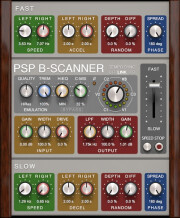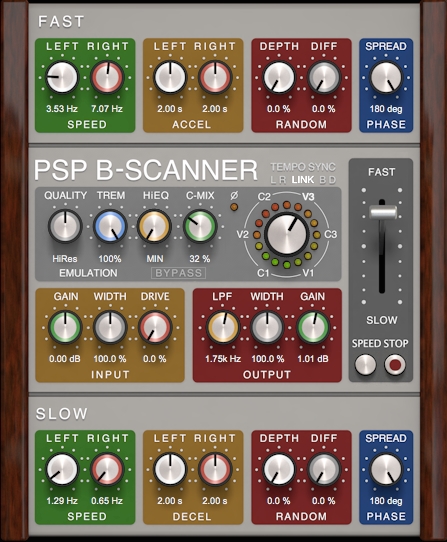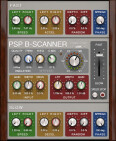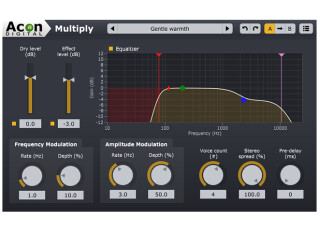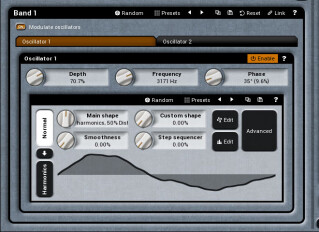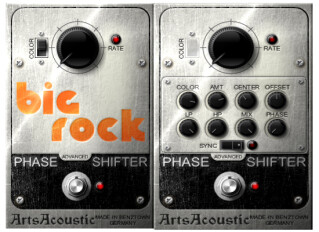Acheter neuf PSP Audioware B-Scanner
- Bax Music Pas de stock / Livré en 24h 78,00 €
Annonces B-Scanner
Alerte nouvelle annonceForums PSP Audioware B-Scanner
News
Vidéos
Fiche technique
- Fabricant : PSP Audioware
- Modèle : B-Scanner
- Catégorie : Autres effets à modulation logiciels
- Fiche créée le : 25/04/2016
a plug-in emulation for Mac OS X and Windows of the analog scanner-based effect available in the vintage Hammond tonewheel organs (such as B-3, C-3, A-100 and others)
designed to recreate the classic sound of the Hammond B-3 Vibrato and Chorus, it offers a wide range of options allowing you to maximize the potential of this unique effect.
This section of the plug-in contains the global parameters controls of the plug-in. These include the Mode Selector, various emulation settings as well as input and output ampliFer settings. The most important parameter is the Mode Selector, allowing you to set the character of the effect by selecting one of six different modes. Other important features include the Speed Lever, which allows you to set the rotation speed, and the Speed and Stop buttons, which are used respectively for switching between speeds and stopping the rotation of the scanner motor completely.
PSP B-SCANNER
Click on this label to open the about box of the plug-in. The about box contains information about this plug-in, the current version number and your authorization details. Click anywhere in the about box area to close it.
SPEED Lever
The speed lever is the main way to smoothly control the speed of the plug-in. It is possible to jump to any chosen position by clicking on that position, or by clicking the SLOW and FAST labels (which automatically set the lever position to minimum/maximum, respectively). Please note that this lever does not control the speed directly as the rotation speed is always subject to inertia – its parameters (acceleration time, deceleration time) can be deFned for both channels in the Slow and Fast sections of the plug-in.
SPEED Button
This button immediately shifts the speed lever to Fast or Slow positions depending on the current state of the plug-in’s speed settings including the previously set speed and lever setting.
STOP Button
Use this button to stop the scanner motor. When clicked, stop mode is engaged and the button illuminates red. The second click of this button disengages stop mode and switches the rotation to its previous settings (as set by the lever).
EMUL ATION
This set of knobs controls various settings of the scanner emulation.
• MODE Selector
The mode selector lets you choose from one of the six modes available in the plug-in: V1, C1, V2, C2, V3 and C3.
6
The control's settings correspond to the Vibrato Switch available on Hammond tonewheel organs equipped with the Selesctive Vibrato system (Hammond A-100, B-2, B-3, C-2, C-3, RT-3 and similar). The setting names beginning with V, indicate Vibrato modes, while the modes beginning with C stand for Chorus modes. The number next to the letter V or C, generally, refers to the perceived “depth” of the chorus or vibrato effect. The larger the number, the stronger the effect.
You may also click on the mode name labels to change the current MODE setting.
-
HiEQ knob – controls the high frequency response (brightness) of the scanner.
-
QUALITY rotary switch – offers the following scanner conFgurations:
◦ B3 – modelled on the classic 16-position scanner,
◦ HiRes – an original 48-position design, much smoother (especially when the scanner motor isrotating at a low frequency, such as 1 Hz).
◦ SMOOTH – softens the output of the scanner further by replacing the scanner with smooth,continuous modulation.
-
TREM knob – controls the amount of the tremolo effect in the scanner emulation.
-
C-MIX knob – controls the chorus mix – the ratio between the wet signal (i.e. processed through the scanner) and the dry (unprocessed) signal. This setting has no effect in the Vibrato (V) modes.
INPUT
There are three knobs in the INPUT section.
-
GAIN knob – controls the scanner input gain.
-
WIDTH knob – sets the input width, values higher than 100% widen the stereo image of the input signal.
-
DRIVE knob – controls the non-linear behavior (saturation) of the scanner emulation. OUTPUT
Similarly to the INPUT section, the OUTPUT section also features three knobs:
-
LPF knob – sets the cutoff frequency of the low-pass Flter processing the output of the scanner.
-
WIDTH knob – sets the stereo width of the output signal, values higher than 100% widen the stereo
image of the output signal.
-
GAIN knob – controls the master output gain.
MODE SWITCH
This switch lets you select how individual rotation speeds and inertia parameters are expressed for the left and the right channel.
-
L R mode – the speed/inertia parameters for both channels are set as separate values (in Hz/seconds, respectively [when the TEMPO SYNC switch is off, otherwise as note values]),
-
LINK mode – the parameters are shown separately (like in the L R mode), but the ratio between them remains constant (within possible range),
-
B D mode – the parameters are shown in BASE DEV pairs consisting of a base value and the deviation, applied to both channels, in opposite directions.
TEMPO SYNC SWITCH
Clicking on the TEMPO SYNC switch toggles the TEMPO SYNC mode. When the TEMPO SYNC mode is enabled, the speeds and inertia parameters for both channels are expressed as note values ranging from a sixty- fourth note triplet to a quadruple whole note. Note values are displayed as fractions with additional symbols, e.g.:
-
1/2 – a half note,
-
1/4. - a dotted quarter note,
-
1/8t – an eighth note triplet,
-
1/16q – a sixteenth note quintuplet,
-
1/32s – a thirty-second note septuplet.
7
BYPASS
Clicking on the BYPASS label will activate the bypass mode. When clicked, the label will turn bright red and all processing inside the plug-in will be bypassed.
PHASE LED
The PHASE LED indicates the rotational phase difference between the left channel and the right channel. The bright-yellow LED is lit when the channels are in-phase and unlit when the channels are out of phase.
SCANNER LED RING
The SCANNER LED RING, located to the right of centre of the EMULATION section, indicates the momentary position of the scanner. When the left-channel scanner is in a position corresponding to a given LED in the RING, the LED will turn bright green.
Similarly, when the right-channel scanner is in a position corresponding to the same LED, the diode will turn bright red. If both channels are in the same position, the LED correlated with that position will turn yellow. In general, the more yellow the LED, the higher the correlation between the momentary phases in the channels.
Fast Section
This section of the plug-in contains the set of controls that conFgure the FAST speed setting parameters.
SPEED
Contains two mode-switch-position-dependent controls: In the L R or LINK modes:
-
LEFT knob – controls the frequency of the fast rotation for the left channel.
-
RIGHT knob – controls the frequency of the fast rotation for the right channel. In the B D mode:
-
BASE knob – controls the base frequency of the fast rotation (for both channels).
-
DEV knob – controls the fast rotation frequency deviation for both channels.
ACCEL
Contains two mode-switch-position-dependent controls: In the L R or LINK modes:
-
LEFT knob – sets the transition time between slow and fast rotation speeds for the left channel.
-
RIGHT knob – sets the transition time between slow and fast rotation speeds for the right channel. In the B D mode:
-
BASE knob – controls the base acceleration time (for both channels).
-
DEV knob – controls the deviation of the acceleration time for both channels.
RANDOM
Contains the following controls:
• DEPTH knob – sets the random speed modulation depth (for both channels) when the Speed Lever is
set to FAST.
• DIFF knob – sets the amount of difference between the FAST random speed modulation in the left
channel and in the right channel (expressed as a percentage).
PHASE SPREAD – controls the scanner position phase offset between the left channel and the right channel (in degrees).
Slow Section
This section of the plug-in contains the set of controls that conFgure the SLOW speed setting parameters.
SPEED
Contains two mode-switch position-dependent controls: In the L R or LINK modes:
8
-
LEFT knob – controls the frequency of the slow rotation for the left channel.
-
RIGHT knob – controls the frequency of the slow rotation for the right channel. In the B D mode:
-
BASE knob – controls the base frequency of the slow rotation (for both channels).
-
DEV knob – controls the slow rotation frequency deviation for both channels.
DECEL
Contains two mode-switch-position-dependent controls: In the L R or LINK modes:
-
LEFT knob – sets the transition time between fast and slow rotation speeds for the left channel.
-
RIGHT knob – sets the transition time between fast and slow rotation speeds for the right channel. In the B D mode:
-
BASE knob – controls the base deceleration time (for both channels).
-
DEV knob – controls the deviation of the deceleration time for both channels.
RANDOM
Contains the following controls:
-
DEPTH knob – sets the random speed modulation depth (for both channels) when the Speed Lever is
set to SLOW.
-
DIFF knob – sets the amount of difference between the SLOW random speed modulation in the left
channel and in the right channel (expressed as a percentage).
PHASE SPREAD – controls the scanner position phase offset between the left channel and the right channel (in degrees).
MIDI Bar which contains a set of MIDI controls and indicators.
MIDI
Click the green arrow icon to load MIDI settings from a file on disk.
Click the red arrow icon to save MIDI settings.
Double click the MIDI label to permanently store the default MIDI settings
Press Command (Mac) or Control (PC) and double click the MIDI label to restore the factory default settings.
Channel Selector
This control allows you to select the MIDI channel to receive MIDI CC messages from. Available settings are MIDI OFF, channel 1-16 or OMNI (receives messages from all MIDI channels).
Display
This display works in two modes. Upon placing the mouse pointer on one of the automatable controls in the plugin editor, it displays the currently assigned MIDI controller (if no controller is assigned, the display will read “not assigned”). If a MIDI CC message is received and the mouse pointer is not placed over one of the controls, this control will display the name of the controller in bright green.
Learn
This control lets the user attach MIDI controller to one of the plug-in’s parameters.
PSP B-Scanner is provided with a factory set of presets
Autres catégories dans Effets à modulation logiciels
Autres dénominations : bscanner


